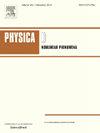具有饱和发病机制的抛物- ode SIS流行病模型的长时间动力学
IF 2.9
3区 数学
Q1 MATHEMATICS, APPLIED
引用次数: 0
摘要
本文研究了异质环境下具有无通量边界条件的抛物- ode SIS流行病模型。该模型包含一个饱和感染机制SI/(m(x)+S+I),其中m≥,⁄≡0。这项研究的动机是疾病控制策略,如隔离和封锁,限制人口流动。我们研究了两种情况:一种是易感人群的流动受到限制,另一种是感染人群的流动被忽视。我们在每个场景中建立解决方案的长期动态。与先前假设不存在饱和发生率函数(即m≡0)的研究相比,我们的研究结果强调了总体人口规模、传播风险水平和饱和发生率函数在影响疾病持久性、灭绝和空间分布方面的新颖而重要的相互作用。数值模拟进行了验证理论结果,并在疾病控制和根除策略的背景下讨论了结果的含义。本文章由计算机程序翻译,如有差异,请以英文原文为准。
Long-time dynamics of a parabolic-ODE SIS epidemic model with saturated incidence mechanism
In this paper, we investigate a parabolic-ODE SIS epidemic model with no-flux boundary conditions in a heterogeneous environment. The model incorporates a saturated infection mechanism with . This study is motivated by disease control strategies, such as quarantine and lockdown, that limit population movement. We examine two scenarios: one where the movement of the susceptible population is restricted, and the other where the movement of the infected population is neglected. We establish the long-term dynamics of the solutions in each scenario. Compared to previous studies that assume the absence of a saturated incidence function (i.e., ), our findings highlight the novel and significant interplay between total population size, transmission risk level, and the saturated incidence function in influencing disease persistence, extinction, and spatial distribution. Numerical simulations are performed to validate the theoretical results, and the implications of the results are discussed in the context of disease control and eradication strategies.
求助全文
通过发布文献求助,成功后即可免费获取论文全文。
去求助
来源期刊

Physica D: Nonlinear Phenomena
物理-物理:数学物理
CiteScore
7.30
自引率
7.50%
发文量
213
审稿时长
65 days
期刊介绍:
Physica D (Nonlinear Phenomena) publishes research and review articles reporting on experimental and theoretical works, techniques and ideas that advance the understanding of nonlinear phenomena. Topics encompass wave motion in physical, chemical and biological systems; physical or biological phenomena governed by nonlinear field equations, including hydrodynamics and turbulence; pattern formation and cooperative phenomena; instability, bifurcations, chaos, and space-time disorder; integrable/Hamiltonian systems; asymptotic analysis and, more generally, mathematical methods for nonlinear systems.
 求助内容:
求助内容: 应助结果提醒方式:
应助结果提醒方式:


